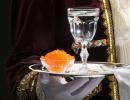Night dormouse. Hazel Dormouse or Mustard
A cute animal that looks like a squirrel, a hamster and a red mouse at the same time, and as if from cartoons - this is a hazel dormouse, which is also called a flycatcher. This charming creature is protected by law - the species Muscardinus avellanarius is listed in the Red Book. Introducing a small rodent from the dormouse family.
Description of the hazel dormouse
The Mushtrap does not belong to hamsters, squirrels, or mice, which it resembles in appearance, although it is also a rodent. The dormouse family includes animals of different sizes, of which the hazel dormouse is the smallest.
Appearance
This tiny rodent weighs no more than 27 grams as an adult (slightly larger than the average size of a regular mouse). This is the maximum weight before hibernation. Only a dormouse, awakened and thin over the winter, weighs only about 15-17 g.
The body of the musky trap is only about 7-9 cm long, not counting the tail, which adds another 6-7 cm. The animal is covered with soft short fur. The coat color is terracotta-red on the back, head and tail, yellowish or whitish on the belly and the inner surface of the paws. The tip of the tail is brown or, conversely, white. Light spots can decorate the chest and abdomen of the animal.
The dormouse's skeleton is capable of shrinking vertically - this allows the animal to curl up into a small ball, take up very little space and squeeze into narrow crevices. The paws are relatively long, flexible, tenacious mobile fingers are clearly visible, also light in color. 4 fingers have the same length, and the fifth, spaced perpendicularly, is slightly smaller.
This is interesting! When a dormouse jumps along branches, its hands unfold almost at right angles.
Sonya has a rounded muzzle with a small pink nose, around which grow very large whiskers, almost half the length of the body. The ears are small, slightly flattened and rounded, they move like locators, each ear separately. The eyes are round, slightly convex, large, shiny black. It has very sharp incisors for gnawing through hard nut shells, but practically does not use them for biting.
Hazel dormouse lifestyle
The animal was named dormouse partly because most Spends days in hibernation, being active only at night. Dormouses also sleep in winter (from October to April) in underground burrows. Thus, more than half of the flycatcher's life is spent sleeping.
Attention! When the animal is sleeping, you can pick it up and it will not wake up. Sonya doesn't like it low temperature, if suddenly in the middle of the heat there is a cold snap to 17 degrees or lower, they can sleep for several days in a row.
At night, dormice crawl out of their shelters and look for food, climbing the branches of bushes, which helps them a lot. little weight and strong flexible legs. They jump from branch to branch like miniature squirrels.
They are trusting and friendly creatures that are easy to tame and can be easily kept at home, like hamsters. These animals were especially popular in Victorian England; in books there are often references to children caring for them. Today there are clubs for dormouse lovers, enthusiasts - those who are not deterred night look the lives of these animals - new hybrid breeds are bred.
Hazel dormouse nests
The animals make comfortable nests for sleeping, which are insulated with moss, wood shavings, leaves, and feathers. The place for a dormouse's "day" can be:
- hollow;
- hole under the roots;
- a hole under an old stump;
- a nest made independently from grass, suspended at a height of 1-2 m;
- a bird's nest, empty or one from which a rodent has evicted its rightful owners.
If the sleepyhead failed to find or make a home for itself from natural materials, she is not averse to taking advantage of the fruits of human hands: curling up in an old tin can or an abandoned car tire. They can take over an empty birdhouse or live in the attic. One dormouse can have several places to spend its days at once. For hibernation Dormouses build a special wintering nest - underground or between the roots of trees. They try to insulate it as much as possible and close the entrance.

To breed offspring, females build a spacious maternity nest, trying to place it at some height from the ground. It is two-layer: the outer shell is made of foliage, and the inner “capsule” is made of the softest materials available to the dormouse - feathers, down, chopped grass.
Lifespan
IN wildlife Dormice do not live long, 2-3 years. As pet can live longer, up to 7-8 years. Cause short life in the wild there are no dangers at all, but mainly temperature fluctuations and environmental troubles. Many animals freeze during hibernation (up to 70% according to data from the Moscow region).
Range, habitats
Dormice do not like to travel, occupying their own territory, separate for each individual. Females do not violate the unwritten boundaries of their territories up to approximately half a hectare, and males cross their territory up to twice that area. The animals meet each other briefly, only during the mating season.
To settle, dormouse choose places with generous undergrowth, preferably hazel (hence the epithet “hazel” in the name of the dormouse). Thickets of rosehip, viburnum, rowan, young oak, linden, and ash are perfect for her life. Dormice settle in orchards, without harming them at all, on the contrary, promoting better pollination. Coniferous forests they like it less, unless they come across a clearing with their favorite fruit bushes.
The dormouse's habitat is quite wide: the animals live throughout Europe, right up to the southern regions of Sweden and Great Britain. You won't find dormouse in Spain and Portugal - it's too hot for them on the Iberian Peninsula. In Russia, dormouse live in forest zones oh the Volga region, the Dnieper region and the Caucasus.
Diet of hazel dormouse
Hazel Dormouse– predominantly vegetarian. She eats nuts, acorns, seeds, which is why it is important that in her habitat the fruits ripen at different time. On warm days early spring The Musktrap is not averse to eating young buds and shoots, and in the summer it will happily eat fresh fruits and berries.

If a rodent manages to find bird eggs or catch a worm, it will not refuse protein food. The animal is especially fond of nuts, which is why the dormouse got its name. Sharp teeth leave characteristic holes on the shell. While eating, the dormouse, like the squirrel, holds food in its front paws.
Class: mammals.
Squad: rodents.
Family: dormouse.
Genus: the classification includes 9 genera.
Habitat in nature: in nature there are 28 species of dormouse, most of which live from North Africa and Asia Minor to Altai, Northwest China and Japan, in sub-Saharan Africa some species of the genus Graphiurus are found isolated, in Europe they are distributed to southern Scandinavia. Most dormouse are forest animals, preferring deciduous and mixed forests; they can be found in forest-steppe areas and in the mountains, where they live at altitudes of up to 3500m. There are 5 species of these rodents found in Russia.
Lifespan: in nature 2-3 years, at home 4-6 years.
Averages: body length 8-20cm, tail 4-17cm. Weight depends on the type of animal, but does not exceed 70g.
Description
Dormouse is a small and medium-sized rodent, with terrestrial forms more like mice, and arboreal forms more like squirrels. The muzzle is sharp or slightly rounded (depending on the species), the ears are small, round, the eyes are bulging, round, large. The tail is usually densely furred, although there are species with a semi-naked tail. The coat is thick and soft, but short. Color depends on the species.
The fur on the back and sides can be from gray to buffy-brown, the belly and paws can be lighter or white. Long, up to 20 percent of the body length, extremely mobile vibrissae, growing like a fan near the nose, are the main tactile organ for the dormouse.
Character
Dormouses are very sociable, lively, active and social animals. They prefer to live in the company of their relatives, but at home it is better to keep them alone or in pairs. These rodents are very cautious and timid, afraid of loud or unexpected sounds, sudden movements. Hazel, African and dormouse quickly get used to people; taming other species requires more attention and patience.
Relationships with other pets
Dormouses that leave their cage can be dangerous to smaller rodents, small birds and lizards. Cats, dogs, ferrets and large birds dangerous for dormice.
Attitude towards children
Dormouses are not very suitable as pets for children.
Education
Dormouses that appear in the house at an early age quickly get used to people, will expect your arrival with food and may get used to taking food from your hands. They can be trained to go out for a treat when called, but they most likely will not become completely tame.
Nutrition
For all types of dormouse, a diet that includes sunflower seeds, hazelnuts, pine and walnuts, melon, watermelon, pumpkin seeds. It is useful to include apples in the dormouse's diet (an adult animal can eat a whole apple overnight), grapes, buds, branch bark, rose hips, dried rowan, viburnum, and dried apricots. In summer it is useful to reduce the amount of oil seeds. Forest, garden and African dormouse require animal food. Mealworms, butterfly pupae, crickets, chafers, snails, large cockroaches are suitable for them; sometimes they can be pampered with raw meat, cottage cheese and eggs.
Care and maintenance
Of the species that live in Russia, the most commonly kept at home are hazel, garden, forest and dormouse. The African dormouse, which is called the dwarf dormouse because of its very small size, is also well suited for keeping as a pet. The hazel and African dormouse are well suited for keeping in a cage; the shelf dormouse can be kept both in a cage and in an aviary, but the garden and forest dormouse it is better to keep them in an enclosure, where you can create a landscape for them that resembles natural environment a habitat.
When keeping dormice in a cage, it is easier to communicate with them, more convenient to observe, and they make contact better. It is advisable to choose a small-meshed, spacious and all-metal cage to avoid the unpleasant odor that permeates the wooden parts of the cage and various infections. Squirrel cages with a spinning wheel are a good choice for them, as these rodents have a very high need for movement. The presence of a retractable tray in the cage makes cleaning and cleaning much easier. You can use sawdust, dry sand or small shavings as bedding. In the cage you need to put heavy food bowls, a drinking bowl, preferably an automatic one, place various ladders, hollow pipes, a hammock, secure ropes and a wheel and attach houses to the lattice where the dormice will build a nest. To make a nest, you can offer them hay, straw, unpainted strips of paper, and small twigs. Every day it is necessary to wash food bowls and drinking bowls, remove leftover food; The bedding should be changed two or three times a week, and the cage should be completely cleaned and disinfected twice a month. Disinfection can be carried out by pouring boiling water over the cage.
Dormouses do not like temperature changes, drafts and direct sunlight, so the cage should be placed at a distance of at least 40 cm from heating appliances and away from windows and doors.
Dormouses are nocturnal animals and may disturb you with noise. However, frequently communicating with humans, dormouse gradually move to daytime look life, especially if you feed them only in the morning and in the evening no later than 19 hours.
With properly equipped housing, dormouse do not need walks. If you decide to get the animal out of the cage, then be prepared for the fact that it can easily escape.
In summer, in dry weather, animals can be taken out to the balcony during the day or the cage can be placed on a table near the house on summer cottage, shading part of the cell from sun rays so that the animals can rest.
Dormouses living in nature hibernate in winter, which can last 6-7 months, but at temperatures above 10°C, dormouse can be active all year round.
Outside the city, these rodents can be kept in an enclosure, where you can recreate a piece of wildlife: make a bedding from moss or peat, place stumps and snags, secure strong branches with hollows, put grass and oats in pots, plant currant bushes, gooseberries, blackberries. Dormouses kept in an enclosure are less amenable to taming, because when a person appears, they hide in various shelters, do not make contact, retain the behavior characteristic of them in the wild, and do not give in to hands. Many owners are happy to talk about their observations of these lively, funny, active animals living in an enclosure. It should be borne in mind that all species of the dormouse family can survive in an enclosure during the winter only in a properly made shelter, built in the ground in the form of an artificial hole, well insulated and covered with a layer of sawdust on top. Before wintering, dormice gain 3-4 times their normal weight. However, you should carefully monitor waking animals: an awakened dormouse can eat a fellow sleeping nearby.




A little history
Unlike many other rodents, dormice came into the homes of animal lovers directly from the wild. In the 20th century, the number of dormouse began to decline rapidly due to destruction natural environment habitat of these rodents as a result of human activity. Many species of dormouse were listed in the Red Book, and programs to restore the population of these cute animals began to be developed all over the world. In the wake of this popularity, dormouse first found their way into the living corners of youth circles, and then into apartments, where they feel very good.
This funny little animal, so similar to either a squirrel or a hamster, is called the hazel dormouse (lat. Muscardinus avellanarius). She became “Hazelnut” because she lives where there are a lot of different nuts, and she was nicknamed “Sonya” because she likes to take a nap during the day.
This is one of the smallest representatives of the dormouse family. The body length of an adult animal is only 7-9 cm with a weight of 27 g. The tail with a tassel is long, almost equal to the length of the body (6-7.7 cm). It is evenly covered with short, soft hair. The hazel dormouse has a blunt muzzle with very large vibrissae, the length of which sometimes reaches 40% of the body length. The ears are small and rounded.

The head, back and tail of the animal are buffy-red, sometimes with a reddish tint. Belly and inner side the paws are yellowish, the chest and lower part of the body are often decorated with white spots. Large and almost round black eyes.

The hazel dormouse lives in Europe and northern Turkey, and can also be seen in southern Sweden and the UK. In general, this cute rodent is quite common in southern Europe, but it is not found in hot Spain. In Russia, the little dormouse is extremely rare. If you're lucky, you can spot it in broadleaf and mixed forests middle lane.

The main condition for the hazel dormouse to live is the presence of a dense undergrowth of hazel, rowan, rosehip, viburnum, bird cherry and other trees and shrubs that can produce crops at different times of the year. In addition, the timid animal loves it when there are many shelters around in which it can hide from terrible predators.

flickr/kleinsaeuger.at
The hazel dormouse builds several residential nests, placing them in tree hollows or simply on branches at a height of 1-2 meters. On occasion, he willingly occupies birdhouses, nest boxes or titmice, without particularly worrying whether someone already lives there or not. It is mainly small birds that suffer from the tricks of the impudent animal, which are not able to fight back.

The dormouse is a territorial animal, and the personal areas of the females never intersect with each other, while the male's area always passes through several areas of the females.

During daylight hours, the dormouse sleeps in one of its nests. When darkness falls, she goes out in search of food. Interestingly, the animal does not immediately leave the shelter. First, he sticks his muzzle out and quickly moves his whiskers, checking to see if there is anyone suspicious nearby. Then the dormouse goes out to the nearest branch and begins to do her toilet.

Having cleaned himself thoroughly, the hazel dormouse goes to full of dangers night travel. A few hours before dawn, well-fed and satisfied, she returns home. The animal feeds on linden nuts, acorns, nuts, beech and other seeds of broad-leaved species. In addition, she willingly eats berries, fruits, young spring buds and shoots. Sometimes her diet includes bird eggs.

In winter, the hazel dormouse hibernates. To do this, she makes herself a warm and reliable nest on the ground or underground, using intertwined roots, burrows of other rodents, and sometimes even old tires or cans. Of course, the animal insulates them with tufts of dry grass, feathers, wool and simply chewed leaves. The lifespan of the hazel dormouse in the wild is 2-3 years.
Nowadays, even the most fanciful breeds of dogs and cats do not cause much surprise, but domesticated wild animals still remain a curiosity. So, in Novosibirsk, the squirrel Sonya became a local celebrity - especially after a news story was filmed about her.

Some families adopt wild animals, consciously preparing for the choice - they first read a lot of information about the future pet, and then buy it at a pet store or at a bird market. For the family that sheltered Sonya, the situation looked completely different: either they take the baby squirrel home and try to get him out, or he dies a slow death from starvation. The fact is that Sonya, at the age of only one and a half months, fell out of the nest, and for some reason her mother did not take her back. The baby had no chance of surviving on her own: she was still feeding on milk and did not know how to get food for herself.

Squirrel Sonya is such a “reverse Mowgli,” jokes the owner of the little squirrel, Elena Ermakova. Now this once wild animal can be considered a domestic animal - the squirrel fits perfectly into the family’s life, it even has its own shelf in the refrigerator where cedar cones are stored “in reserve.” Moreover, Sonya loves to sit on Elena's shoulder and does not mind a harness with a leash. So, sitting on her shoulder, Sonya goes out into the street, where she immediately attracts the attention of all passers-by and children playing in the local playground. Sonya likes to run through the trees, but according to Elena, the animal never runs away.

Interestingly, the squirrel Sonya responds to her name - just like a pet. But at the same time, it has also retained the instincts of life in the wild: for example, the squirrel constantly stores and hides seeds, nuts and cones in the most unexpected places, from the pockets of sweaters and outerwear to flower pots. If Sonya happens to meet other squirrels, she is in no hurry to share her supplies with them. Now for her, family is people.

Of course, keeping such an unusual animal is associated with various difficulties: these are the already mentioned “nut stash,” and the desire to gnaw on everything that comes across, and incredible mobility. But for the owner, Sonya is still the best in the world. “Watching a domestic squirrel,” says Elena, “is a pleasure: no other domestic animal brings so much joy.” And at the same time, she does not advise taking such a pet home without unnecessary need.


This small animal is very similar to an ordinary mouse, but with a fluffy “squirrel” tail. Externally, there are two types of dormouse - mouse-shaped and squirrel-shaped. The former have a bare tail and live on the ground, the latter live in trees. Dormice are very small animals; an adult animal can easily fit in the palm of your hand. They are active mainly at night. These animals began to be domesticated relatively recently, in the last century, due to a decrease in the number of individuals of the species. Thanks to the technological progress of the last century, the number of forest areas where these animals live has decreased significantly, and the dormouse was listed in the Red Book, and also began to be bred under artificial conditions in order to prevent the extinction of the species.
Titles in other languages:
The name of the dormouse in Latin sounds like Myoxidae or Gliridae. There is also a Latin name for the dormouse subfamily, Graphiurinae. On English language"dormouse" sounds like Dormouse, and in German it sounds like Siebenschlaefer.
Classification:
Dormouses belong to the animal kingdom, the phylum of chordates, the subphylum of vertebrates. Dormice are mammals of the placental subclass. Of course, these are rodents that belong to the squirrel-shaped ones, the dormouse family. In total, 9 genera and 28 species of these animals are known in nature.
Dormouse habitat:
These rodents are mostly found in steppes and forest-steppes. The main regions of their habitat are the northern part of Africa, China and Japan, Altai, and Asia Minor. And in southern Africa there are even separate species animal, which is called the African dormouse. Other genera of this rodent prefer more cool climate. The most common dormouse are those that live in trees. For example, a dormouse can live its entire life on a tree. Woody species They settle mainly in hollows or nests; terrestrial ones dig burrows near tree roots or fallen trunks. There are also garden species of these animals; they cause great damage to gardens, destroying cultivated plants.
Sony Description:
Mouse-like animals, as the name suggests, look like mice, and squirrel-like animals look like squirrels. On average, dormouse grow up to 10 cm, sometimes 20-centimeter individuals are found. They have cute round ears and beady eyes. Dormice, thanks to their sharp claws, can cling well to tree bark. Some members of the family may be missing one claw on the hind paw. If you place the animal in your palm, you can feel the hard pads on the animal’s paws. The dormouse's fur is reddish-gray, very soft and long, the hairs are smooth and reach 17 cm in length. The squirrels have a very prominent fluffy tail. Winter for dormice is a period of hibernation. As for a rodent, the dormouse lives relatively long - in nature up to 5 years, in captivity no more than 3 years.
Sony power supply: Tree dormouse feed on what mainly grows and lives in trees. These are nuts, seeds, tree fruits, small insects. Ground dormice are more herbivorous; they love various grasses, dandelion leaves, clover, and nettles. Dormouses living in trees destroy birds' nests in order to feast on their eggs. This breed of rodents is also characterized by a predatory trait; they can eat other, smaller animals. If a dormouse is kept at home, it is preferable for her to diversify her diet with plant foods - grains, seeds, fruits, nuts, and sometimes bread and carrots. There is also no need to exclude animal foods. You can occasionally pamper your pet with boiled meat, milk, cottage cheese, and chicken eggs. And for some species, animal products are even more important in the diet than vegetation. Insects and eggs should always be present in the feeder of garden and African dormouse. You can also breed special mealworms for dormouse nutrition. If you add fish oil to your dormouse's food, the animal's body will receive even more vitamins and nutrients.
Tree dormouse feed on what mainly grows and lives in trees. These are nuts, seeds, tree fruits, small insects. Ground dormice are more herbivorous; they love various grasses, dandelion leaves, clover, and nettles. Dormouses living in trees destroy birds' nests in order to feast on their eggs. This breed of rodents is also characterized by a predatory trait; they can eat other, smaller animals. If a dormouse is kept at home, it is preferable for her to diversify her diet with plant foods - grains, seeds, fruits, nuts, and sometimes bread and carrots. There is also no need to exclude animal foods. You can occasionally pamper your pet with boiled meat, milk, cottage cheese, and chicken eggs. And for some species, animal products are even more important in the diet than vegetation. Insects and eggs should always be present in the feeder of garden and African dormouse. You can also breed special mealworms for dormouse nutrition. If you add fish oil to your dormouse's food, the animal's body will receive even more vitamins and nutrients.
Reproduction of dormouse:
Already from the first month of life, dormice are ready to reproduce. Period mating games comes in the spring. Females produce offspring mainly once a year. Almost all types of dormouse, except the common dormouse, reproduce well both in natural and at home conditions. The female carries the cubs for a month, after which naked and blind babies are born. There are up to 10 of them in a litter, and they feed on mother’s milk for up to 3 weeks. Little sleepyheads are very attached to their mother, so it is impossible to tear them away from her ahead of time, this can become serious stress for the babies. It is curious that dormouse care for their young together with their fathers, a “full-fledged” family.
Maintenance and care of the dormouse: Sonya are known for their unpretentiousness and peacefulness. They calmly get along with several animals in one enclosure or cage. The animals feel good in spacious enclosures, because in a cramped cage the dormouse will not be able to move actively enough and will begin to gain excess weight. It is best for a dormouse to equip a home that is as close to its natural habitat as possible. You can lay moss or a layer of peat on the floor of the enclosure, and lay out twigs, bark, and stumps on it. You can grow edible plants, grass, gooseberry or currant bushes right in the dormouse's home. For the hibernation of these small animals, it is necessary to equip a cozy corner. A pipe leading from the hole to a small box insulated with dry hay is suitable for this. If a dormouse lives in a cage, it must be equipped with all the necessary attributes for rodents - a drinking bowl, sawdust on the floor, a bowl, a tray, toys. Dormouses love to tinker with their nests, so in the cage you can hang a small wooden box with a set of “building materials”: twigs, hay, etc.
Sonya are known for their unpretentiousness and peacefulness. They calmly get along with several animals in one enclosure or cage. The animals feel good in spacious enclosures, because in a cramped cage the dormouse will not be able to move actively enough and will begin to gain excess weight. It is best for a dormouse to equip a home that is as close to its natural habitat as possible. You can lay moss or a layer of peat on the floor of the enclosure, and lay out twigs, bark, and stumps on it. You can grow edible plants, grass, gooseberry or currant bushes right in the dormouse's home. For the hibernation of these small animals, it is necessary to equip a cozy corner. A pipe leading from the hole to a small box insulated with dry hay is suitable for this. If a dormouse lives in a cage, it must be equipped with all the necessary attributes for rodents - a drinking bowl, sawdust on the floor, a bowl, a tray, toys. Dormouses love to tinker with their nests, so in the cage you can hang a small wooden box with a set of “building materials”: twigs, hay, etc.
Additionally:
Dormice are not only loved to be kept as pets. They are also valued for their good fur as fur-bearing animals. The skin of the dormouse was especially prized; at one time special hunts were organized for them. In general, this is a very curious species; the dormouse has an excellent appetite and by the autumn period it is gaining heavy weight, but still makes large reserves for the winter in its nest.






